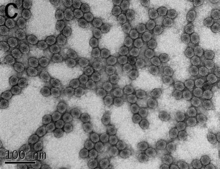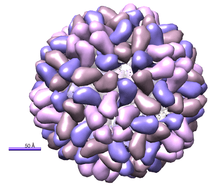Bromoviridae
Bromoviridae is a family of viruses.[2] Plants serve as natural hosts. There are currently 36 species in this family, divided among 6 genera.[3][4]
| Bromoviridae | |
|---|---|
 | |
| Transmission electron micrograph of brome mosaic virus (BMV) virions | |
 | |
| Crystal structure of Brome mosaic virus, PDB entry 1js9[1] | |
| Virus classification | |
| (unranked): | Virus |
| Realm: | Riboviria |
| Kingdom: | Orthornavirae |
| Phylum: | Kitrinoviricota |
| Class: | Alsuviricetes |
| Order: | Martellivirales |
| Family: | Bromoviridae |
| Genera | |
|
Alfamovirus | |
Taxonomy
Group: ssRNA(+)
- Family: Bromoviridae
- Genus: Alfamovirus
- Genus: Anulavirus
- Amazon lily mild mottle virus
- Pelargonium zonate spot virus
- Genus: Bromovirus
- Broad bean mottle virus
- Brome mosaic virus
- Cassia yellow blotch virus
- Cowpea chlorotic mottle virus
- Melandrium yellow fleck virus
- Spring beauty latent virus
- Genus: Cucumovirus
- Cucumber mosaic virus
- Gayfeather mild mottle virus
- Peanut stunt virus
- Tomato aspermy virus
- Genus: Ilarvirus
- American plum line pattern virus
- Apple mosaic virus
- Asparagus virus 2
- Blackberry chlorotic ringspot virus
- Blueberry shock virus
- Citrus leaf rugose virus
- Citrus variegation virus
- Elm mottle virus
- Fragaria chiloensis latent virus
- Humulus japonicus latent virus
- Lilac leaf chlorosis virus
- Lilac ring mottle virus
- Parietaria mottle virus
- Prune dwarf virus
- Prunus necrotic ringspot virus
- Spinach latent virus
- Strawberry necrotic shock virus
- Tobacco streak virus
- Tulare apple mosaic virus
- Genus: Oleavirus
- Olive latent virus 2
Structure
Viruses in the family Bromoviridae are non-enveloped, with icosahedral and bacilliform geometries. The diameter is around 26-35 nm. Genomes are linear and segmented, tripartite.[3][4]
| Genus | Structure | Symmetry | Capsid | Genomic arrangement | Genomic segmentation |
|---|---|---|---|---|---|
| Ilarvirus | Icosahedral | T=3 | Non-enveloped | Linear | Segmented |
| Anulavirus | Icosahedral | T=3 | Non-enveloped | Linear | Segmented |
| Bromovirus | Icosahedral | T=3 | Non-enveloped | Linear | Segmented |
| Oleavirus | Icosahedral | T=1 | Non-enveloped | Linear | Segmented |
| Alfamovirus | Varies | Non-enveloped | Linear | Segmented | |
| Cucumovirus | Icosahedral | T=3 | Non-enveloped | Linear | Segmented |
Life cycle
Viral replication is cytoplasmic, and is lysogenic. Entry into the host cell is achieved by penetration into the host cell. Replication follows the positive stranded RNA virus replication model. Positive stranded rna virus transcription, using the internal initiation model of subgenomic rna transcription is the method of transcription. The virus exits the host cell by tubule-guided viral movement. Plants serve as the natural host. Transmission routes are mechanical and contact.[3][4]
| Genus | Host details | Tissue tropism | Entry details | Release details | Replication site | Assembly site | Transmission |
|---|---|---|---|---|---|---|---|
| Ilarvirus | Plants | None | Viral movement; mechanical inoculation | Viral movement | Cytoplasm | Cytoplasm | Mechanical inoculation: insects; contact |
| Anulavirus | Plants | None | Viral movement; mechanical inoculation | Viral movement | Cytoplasm | Cytoplasm | Unknown |
| Bromovirus | Plants | None | Viral movement; mechanical inoculation | Viral movement | Cytoplasm | Cytoplasm | Mechanical inoculation: insects; contact |
| Oleavirus | Plants | None | Viral movement; mechanical inoculation | Viral movement | Cytoplasm | Cytoplasm | Mechanical inoculation: insects; contact |
| Alfamovirus | Plants | None | Viral movement; mechanical inoculation | Viral movement | Cytoplasm | Cytoplasm | Mechanical inoculation: insects |
| Cucumovirus | Plants | None | Viral movement; mechanical inoculation | Viral movement | Cytoplasm | Cytoplasm | Mechanical inoculation: insects; contact |
References
- Lucas, R. W.; Larson, S. B.; McPherson, A. (2002). "The crystallographic structure of Brome mosaic virus". Journal of Molecular Biology. 317 (1): 95–108. doi:10.1006/jmbi.2001.5389. PMID 11916381.
- Bujarski, J; Gallitelli, D; García-Arenal, F; Pallás, V; Palukaitis, P; Reddy, MK; Wang, A; ICTV Report, Consortium (August 2019). "ICTV Virus Taxonomy Profile: Bromoviridae". The Journal of General Virology. 100 (8): 1206–1207. doi:10.1099/jgv.0.001282. PMID 31192783.
- "ICTV Report Bromoviridae".
- "Viral Zone". ExPASy. Retrieved 15 June 2015.
External links
| Wikimedia Commons has media related to Bromoviridae. |